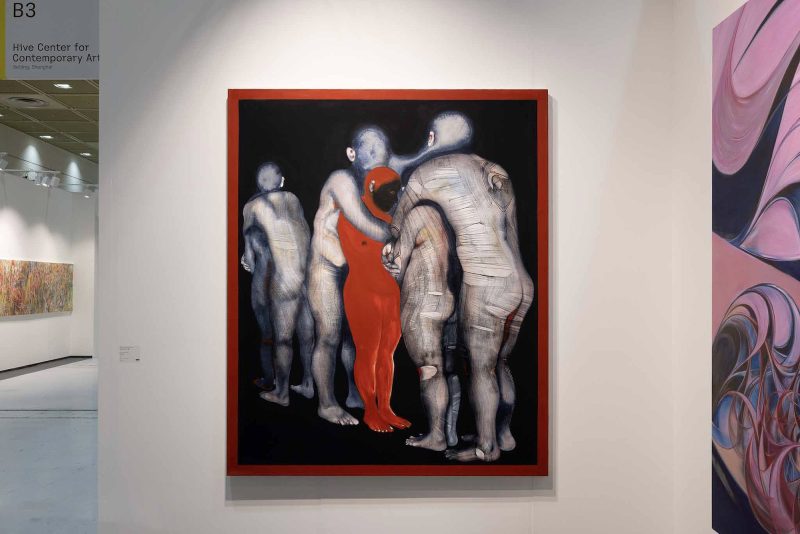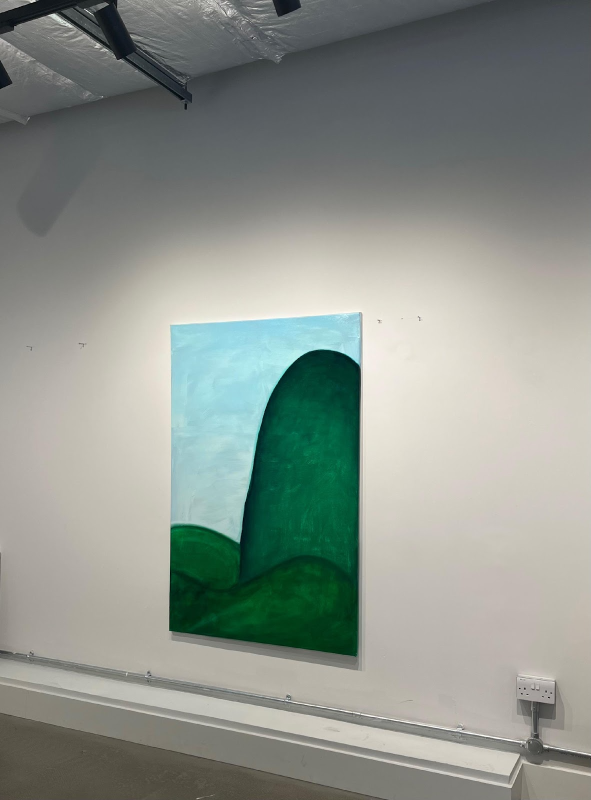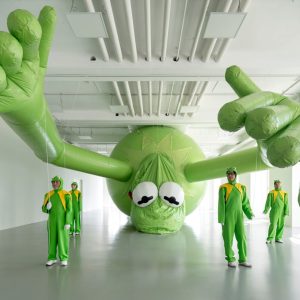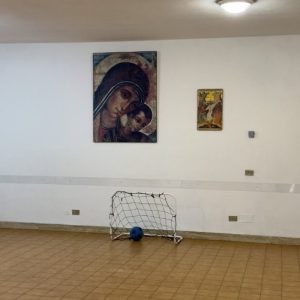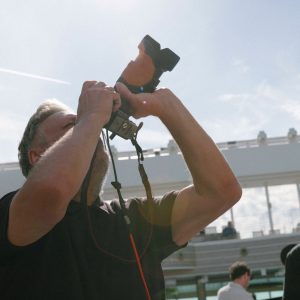For the latest instalment of my column highlighting some of the most exciting emerging artists working in the UK and globally, I spoke to Yurim Gough, a talented fine art ceramicist who merges the draughtsmanship and gender fluid mind-set of Grayson Perry with the autobiographical honesty of Tracey Emin.
Yurim was born in South Korea where she had a successful early career as a shoe designer, working in Tokyo and London, before moving to the UK where she pursued a career as a fine artist and ended up settling in Cambridge where she has a studio.
Yurim has a solo exhibition, Vain Ego, coming up at APT Gallery London in May 2022, and is also working on a new series Gender-Fluid for a group show at the prestigious Fondation d’entreprise Bernardaud in Limoges, the famed centre of ceramics where Picasso made some of his most iconic ceramic works.
The solo exhibition at APT gallery will be the result of 6 years work triggered by Gough’s breast cancer diagnosis in 2016 and subsequent treatment and recovery. During this challenging time, Gough sought solace in her work, expressing the emotions and experiences of her cancer treatment through life drawing and ceramics.
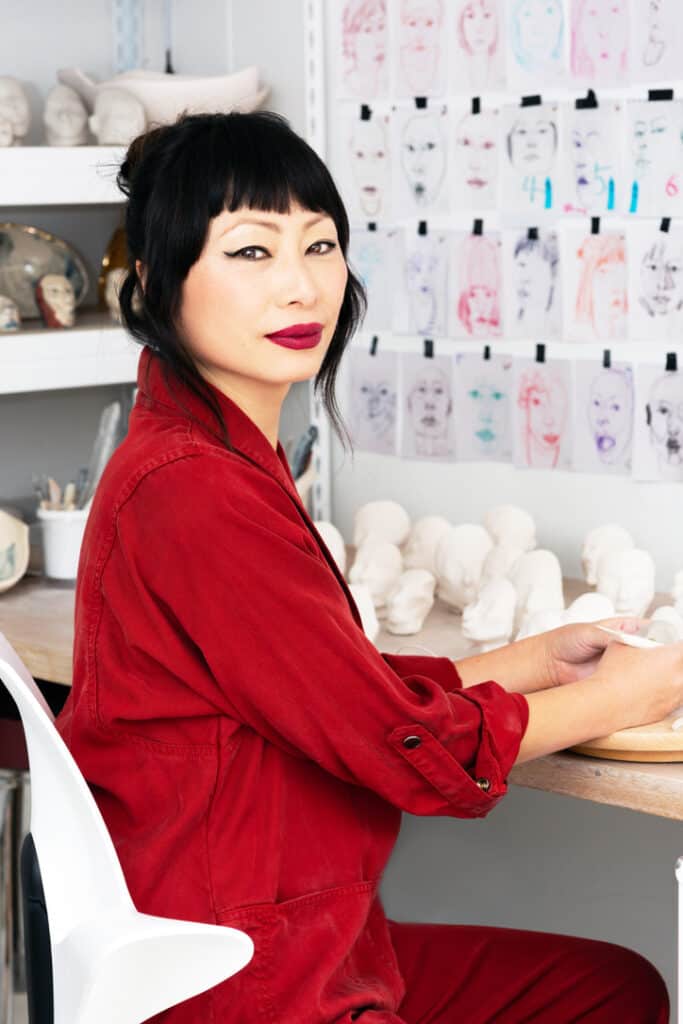
Lee Sharrock: Your career had an earlier incarnation as a successful shoe designer in Korea, Tokyo and London. How did you move from fashion into contemporary art? And does your experience in the fashion world influence your ‘eye’ as a ceramicist?
Yurim Gough: If I had stayed in Korea, I would probably have continued working on shoe design. The life of a shoe designer was a fantasy world for me. I loved this job so much. It took me five years to resume my design work due to language barriers and cultural shocks that came naturally when I moved to England. Of course, during this break, I was able to think a lot about what I really wanted to do in the future, and I also thought carefully about looking back on my childhood dream of becoming an artist. But I still had lingering feelings about doing shoe design, so I wanted to try again. Luckily, I was able to work for a London company again as a shoe designer for a few months. However, I realized that it was no longer right for me to go through the stress from this kind of work again and engage in what I call the invisible fight with my competitors.
In the end, I strongly felt that becoming an artist, my childhood dream, was the path of my destiny. I learned the genres of art and crafts in various fields. Then, I was fascinated by something thrilling that I felt while touching clay. When I was young, I was not even interested in pottery at all, but now I choose it as an important material for my artwork.
After working as a shoe designer for 10 years, I started my career as an artist at a late stage in my 30s. I thought ‘design’ and ‘art’ were completely different things, but I realized that they weren’t. My designer career and experiences so far are very helpful in making my work now. In this way, design and art coexist together. Since I have worked as a designer, it is becoming a strong foundation for my artwork now, and that’s why I think it’s my own strength to be able to create and look at art with a slightly different eye.
You were born in Korea where there is a rich history of ceramic art, dating all the way back to the oldest earthenware around 8,000 BC. Although your ceramics are very contemporary, do you draw on the Korean artisanal traditions, such as the geometric sunshine patterns of the Neolithic period, or the Mumun pottery technique of making red and black colours from minerals?
When I became interested in ceramics for the first time it was after my life started in the UK, and I also learned that Korea is well known for traditional pottery.
For the first time, I was making a bowl in a pottery hobby class, and the teacher said to me, “I guess the blood of ancestors flows in your body Yurim! you’re really good!” Of course, I then had a great interest in pottery right away. Moreover, “the blood of my ancestors” pottery flows through my body!!!!’ I thought it is really an irreversible fate.
When I was young, I had no interest in history, just as I had no interest in pottery. I was more interested in the present and future. History was a boring past story for me, like a dead body. Like me living, I felt a stronger attraction to something alive. Now I can see that I can find ways to live well in the present based on history. Perhaps what you don’t know is sometimes better than what you know. In my case, I turn these shortcomings and weaknesses into strong advantages, so my art may not be the same as anyone else’s and so it may seems special!
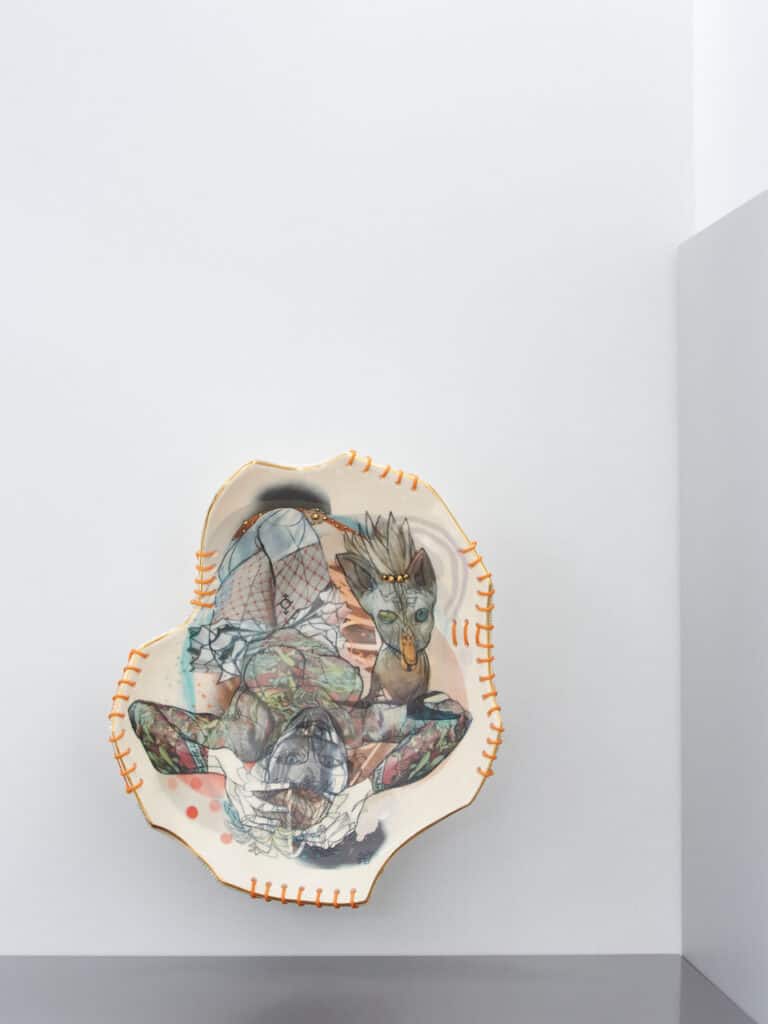
Your work reminds me of Grayson Perry’s in the way that you both tell a narrative with a 3 dimensional object. And there is also an autobiographical element reminiscent of Tracey Emin, particularly in your ‘Vain Ego’ series which documents your journey through breast cancer, when you did a series of self-portraits at different stages of your treatment and recovery. Is it important to you that your work tells a story, and was making it during your cancer journey a cathartic process?
Grayson Perry and Tracey Emin, I think are magnificent living artists. Their art is honest, they are not ashamed or afraid of expressing themselves.
When I was young, I cried so much and it became a habit so I had to cry at least once a week. Looking myself in a mirror staring at my eyes, just only looking at them made me cry! And after crying, I felt better and something was gone and released.
Yes, the Vain Ego project was a 100% cathartic process. Focusing on creativity was a great tool to release emotions, weakness and pain, especially after I found that I had breast cancer and the subsequent treatment and recovery. I also got a strong spiritual feeling from the creative process and that I was able to survive from the cancer journey.
The intensity and raw sexuality of some of your portraits are very expressionistic, and often reminds me of the 19th century Viennese artist Egon Schiele. Is Schiele or any other artist an influence on your work?
My first thought was: “Nude! Taking it off can’t help but be sexy”. I think there are few artists who are not influenced by Schiele – what he and I have in common is ‘life drawing’. Those who see my work always talk about Schiele’s work! One day, I compared his work with mine and found the following in common:
1. Life drawing with a pencil.
2. The pencil line is strong and absolute.
3. You can see the current fashion trend.
4. We both like to draw ourselves.
However, I found that when I put my images side by side with Schiele’s, I realize that they are completely different. Various images have a great influence on my artwork. It may be an artist’s work, it may be just a picture of a person, or it may be a product. The source that jumps in my eyes and stays in my eyes for more than five seconds is the source that has the greatest influence on my work.
You will be exhibiting in Limoges in a group show next year. Limoges has a rich history of ceramics dating back to the late 18th Century, and most famously, Picasso’s ceramics were crafted in Limoges, including his iconic ‘Dove of Peace’ which he created for the 1949 World Congress of Advocates for Peace. What will you be exhibiting in Limoges, and will you be using Limoges porcelain to create your piece? (A hard-paste porcelain produced in Limoges).
When I first started selling my work, I recognized myself as an artist. In the meantime, many people have called me a ceramicist, but I have never recognized myself as such. The reason is that I’ve never had a formal education in pottery, all I know is that I’m creating it.
For eight years like that, it has grown only in terms of a growing acceptance within the art world. Then earlier this year, Foundation Bernardaud invited me to their 10-month group exhibition with ceramic artists, and it is truly a great fortune to display my work alongside ceramicists. I feel like I’ve been chosen for the Lottery! I am very proud of myself that I am only one Korean out of 11 ceramicists worldwide in this exhibition.
This exhibition will be exhibited in July 2022 in a very nice space in Limoges, France, and will showcase nine pieces of my latest series: Gender-fluid. If I have a chance, I want to see the works made of traditional Limoges porcelain when I am there, and the process of making them with my own eyes, and I also want to experience them.
Can you tell me a bit about your Vain Ego series that you’ll be exhibiting at APT gallery next spring?
This exhibition records my breast cancer fighting experience and various emotions in my work. As soon as I was first diagnosed with breast cancer in 2016, I drew a clear image of the exhibition for this project. Finally, in six years, such imagination will be perfectly held at APT Gallery for three weeks from May 12, 2022.
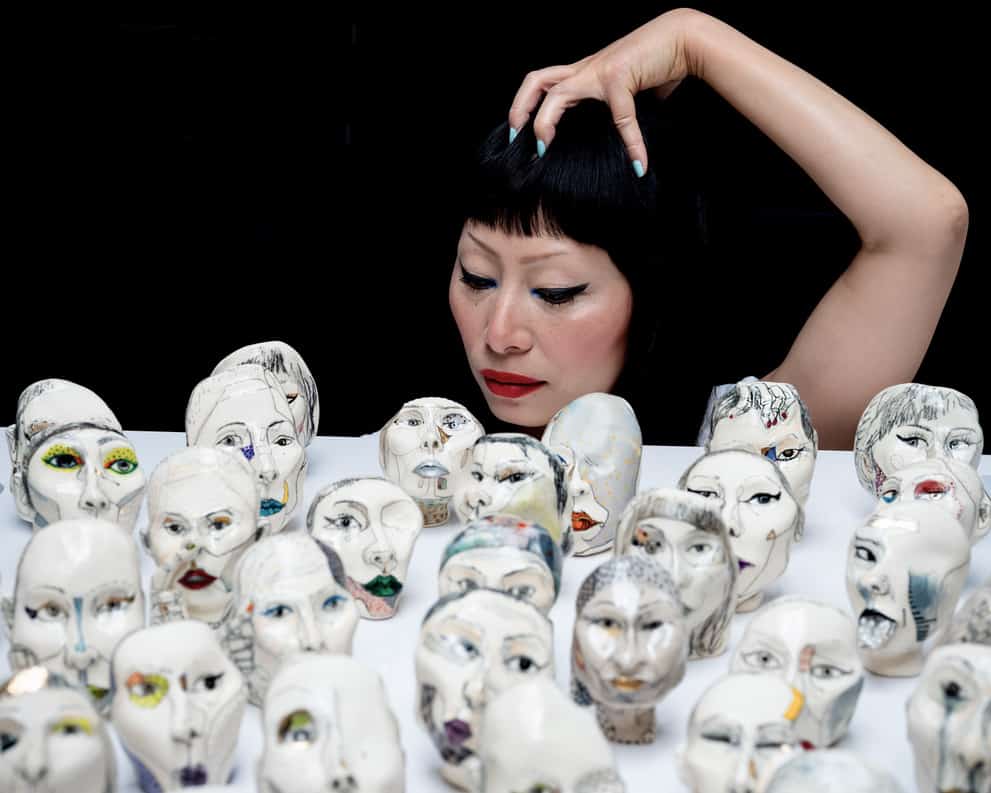
Photo credit: Daniele Roberts Mah
Vain Ego consists of one word and depicts myself in the mirror looking for my ego. As the fight against cancer began I drew my feelings, which changed from day to day, and I also drew my changing body nude onto a ceramic bowl. In addition, photographs and videos of myself at that time will also be presented for the first time in this exhibition. Life drawing drawn on pottery is decorated with my life story, and it is an unforgettable memory from the time I was born to the stage of coming to England.
In addition, 108 Vain Ego “Army of me” are heads created at the time of Covid lockdown by selecting 108 sketches out of 162 self-portraits from the time of my cancer diagnosis and treatment, and sculpting them in three dimensions.
The purpose of this exhibition is, ‘Things that you know but forget but don’t say…’ These things are what makes the audience see breast cancer more intimately and also experience one’s innermost thoughts visually. And you will also feel at this exhibition that art has made me live.
You’re currently working on a series of ceramics with portraits of gender fluid sitters. What interests you in this area, and how do you find your subjects and make them feel comfortable during life drawing sittings?
The first time I started to be interested in this field was when I was working as a designer in Seoul. In Itaewon in Seoul, there were many gay clubs and bars, especially transgender bars. I was fascinated by the beauty of them, and I enjoyed their style and appearance.
When I started living in the UK, I easily found gender fluid people on the street and TV or in the world of social media. For me, it looked much more settled in the culture in England than in South Korea. I fell for their confidence and their charms again.
This project started very simply. All I knew about the subject was the appearance, and I was fascinated by their unique charm and excellent taste of fashion. It was an inevitable concern for me who worked in fashion. That’s how this project started, but it approached the subject very carefully. As I started researching, I was able to know little by little the difficulties and pains they were struggling with. And I tried to understand from their perspective. I am still learning and getting the pronouns wrong; I hope people don’t mind because anyway English is hard for me. The information I learned so much about and emotions were drawn into my work. Indeed, this work with the models of the four Gender-Fluid who I had the fortune to meet, had a great influence on my work activities. Nine works have been being made since the beginning of this year, and these works will be at the ceramic group exhibition in France in the summer of 2022.
I think it’s very natural for us humans to wonder about the world we don’t know. It will be similar to the question of “How does Yurim work with the models in her studio?”
I’ve been doing life drawing on and off for over 20 years. First of all, I don’t try anything that the model is uncomfortable with or doesn’t want to do. I can work comfortably only when the model is comfortable. It is not that difficult to create good energy between us with a pleasant atmosphere.
Your ceramics are so unique, merging draughtsmanship with vibrant colour, storytelling and interventions into the ceramic with thread and other materials. What is your process/ technique when you are creating each ceramic, and do you create everything in your studio in Cambridge?
My project ideas always fill one wall of my studio with inspirational images from magazines and other media. These are information about what topics to select and what stories to draw.
When the project is selected, the model planning work begins. In my studio, where various shapes of ceramic bowls are prepared on one side, I explain my project to the model and discuss ideas with various images that I drew.
The model poses in the selected costumes, and I take a picture. After that, the model takes off the costume and takes the previous pose again, but nude. I draw the model at once without hesitating to erase or modify it in a ceramic bowl. After that, I apply glaze and fire one more time.
After printing the photos of the models taken in costumes onto ceramic transfers, they are applied on top of the glazed life drawing bowl I cut the transfers and applied them to the shape.
In addition, I use abstract paintings drawn using an iPad to fill the surroundings of the human figure painting the background with images. After that, I fire it for the third time and then draw a border with gold and fire it for a fourth time. After this I use a porcelain pen to brighten the colour and fire it for a fifth time.
It is then decorated with threads, 3D printed parts, and crystals. All of this is being done in Cambridge, where my small square box studio is located.
Upcoming exhibitions: Fondation d’entreprise Bernardaud, Limoges: June 2022 to March 2023.
APT gallery London: 12th May 2022 – 29th May 2022. Yurim Gough: yurimgough.com

